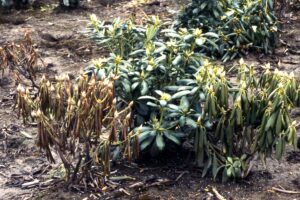by Leslie Cox; Monday; March 24, 2025
Phytophthora
(pronounced fy-TOFF-thor-ah)
The word Phytophthora is blended from two Greek words – phyton meaning “plant” and phthora meaning “destruction”. Pretty apt because this is one group of microorganisms which are really deadly to plants.
Resembling fungi, which they are not, Phytophthora are closely related to aquatic organisms like algae so they are more often labeled as water molds even though they can exist on land. However, they do need water to complete their life cycle.
Within the Phytophthora genus are species which are specifically deadly to the trees in our forests, fruit and nut trees, as well as vegetable and nursery crops. In fact, Phytophthora is the number one disease of nursery crops across the country. The most notorious diseases are potato late blight, rhododendron root rot and sudden oak death.
To appreciate the full scope of potential damage to crops, nurseries and forests…there have been almost 240 different species of Phytophthora identified. So far. But, like many microorganisms with their ability to mutate and adjust to variances in their environment, scientists are regularly discovering new Phytophthora species to add to that list.
The best defense we have at our disposal to thwart potential harm to our plants from this deadly pathogen species is to ensure good drainage, provide the nutrients they need and maintain cleanliness in the garden by removing any diseased, dead and decaying plant material immediately.
Photo credit Pacific Northwest Handbooks on plant diseases
Photo shows dead plant from rhododendron root rot on left and a diseased plant on right.
Plant in centre not showing any signs yet but highly likely to be infected due to proximity to diseased plants.

